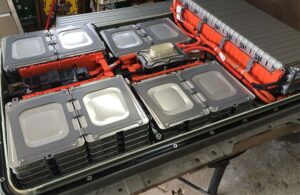In efforts to combat high surface resistance that causes solid state batteries to have low output, Researchers have developed a novel technique to investigate and modulate electric double layer dynamics at the solid/solid electrolyte interface.
 The researchers demonstrate unprecedented control of response speed by over two orders of magnitude, a major steppingstone towards realization of commercial all-solid-state batteries.
The researchers demonstrate unprecedented control of response speed by over two orders of magnitude, a major steppingstone towards realization of commercial all-solid-state batteries.
In our quest for clean energy and carbon neutrality, all-solid-state lithium-ion batteries (ASS-LIBs) offer considerable promise. ASS-LIBs are expected to be used in a wide range of applications including electric vehicles (EVs). However, commercial application of these batteries is currently facing a bottleneck—their output is reduced owing to their high surface resistance. Moreover, the exact mechanism of this surface resistance is hitherto unknown.
Researchers have alluded it to a phenomenon called the “electric double layer” (or EDL) effect seen in colloidal substances (which are microscopic dispersions of one kind of particle in another substance). The EDL effect occurs when colloidal particles gain negative electric charge by adsorbing the negatively charged ions of the dispersion medium on their surface.
“This occurs at the solid/solid electrolyte interface, posing a problem in all-solid-state lithium batteries,” explains Tohru Higuchi, Associate Professor at Tokyo University of Science (TUS).
Higuchi, along with colleagues Makoto Takayanagi from TUS, and. Takashi Tsuchiya and Kazuya Terabe from National Institute for Materials Science in Japan, has devised a novel technique to quantitatively evaluate the EDL effect at the solid/solid electrolyte interface.
An article detailing their technique was made available online on 8 February 2023 and was published in Volume 31 of Materials Today Physics. The researchers employed an all-solid-state hydrogen-terminated diamond (H-diamond)-based EDL transistor (EDLT) to conduct Hall measurements and pulse response measurements that determined EDL charging characteristics. By inserting a nanometer-thick lithium niobate or lithium phosphate interlayer between the H-diamond and lithium solid electrolyte, the team could investigate the electrical response of the EDL effect at the interface between these two layers.
The electrolyte’s composition did, indeed, influence the EDL effect in a small region around the electrode interface. The EDL effect was reduced when a certain electrolyte was introduced as an interlayer between the electrode/solid electrolyte interface. EDL capacitance for the lithium phosphate/H-diamond interface was much higher compared to the lithium niobate/H-diamond interface.
Their article also explains how they improved the switching response time for charging ASS-EDLs. “The EDL has been shown to influence switching properties, so we considered that the switching response time for charging ASS-EDLs could be greatly improved by controlling the capacitance of the EDL. We used the non-ion-permeable property of diamond in the electron layer of the field-effect transistor and combined it with various lithium conductors,” Higuchi narrates.
The interlayer accelerated and decelerated the EDL charging speed. The electrical response time of the EDLT was highly variable—it ranged from about 60 milliseconds (low speed switching for lithium phosphate/H-diamond interface) to about 230 microseconds (high speed switching for lithium niobate/H-diamond interface). The team, however, exhibited control over the EDL charging speed for over two orders of magnitude.
In summary, the researchers were able to achieve carrier modulation in all-solid-state devices and improved their charging characteristics. “These results from our research on the lithium-ion conductive layer are important for improving the interface resistance and may lead to the realization of all solid-state batteries with excellent charge-discharge characteristics in the future”, notes an optimistic Higuchi.
Taken together, this is a major steppingstone towards controlling the interface resistance of ASS-LIBs that catalyzes their feasibility for many applications. It will also help design better solid-electrolyte-based devices, a class of gadgets which also includes neuromorphic devices.
